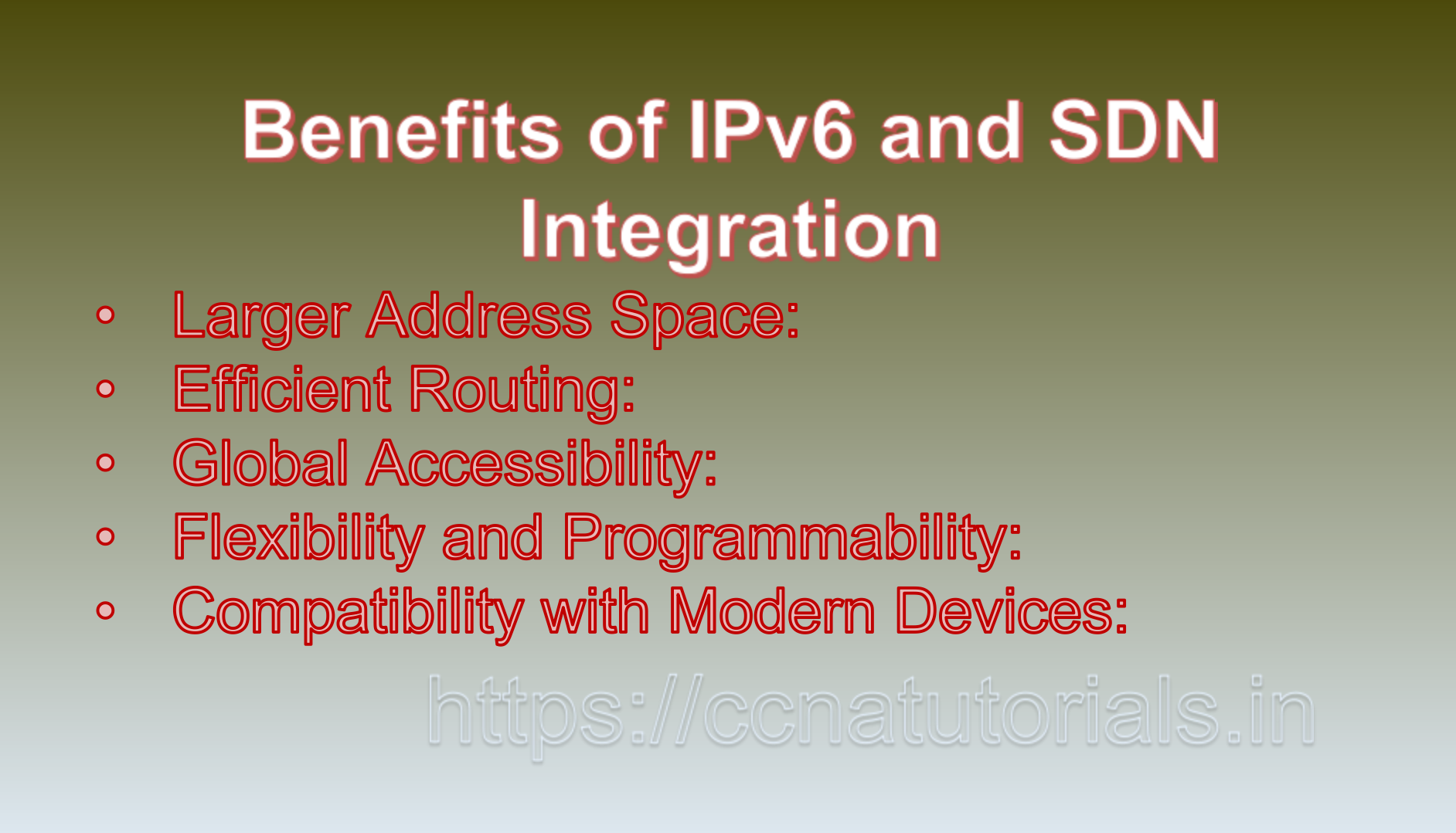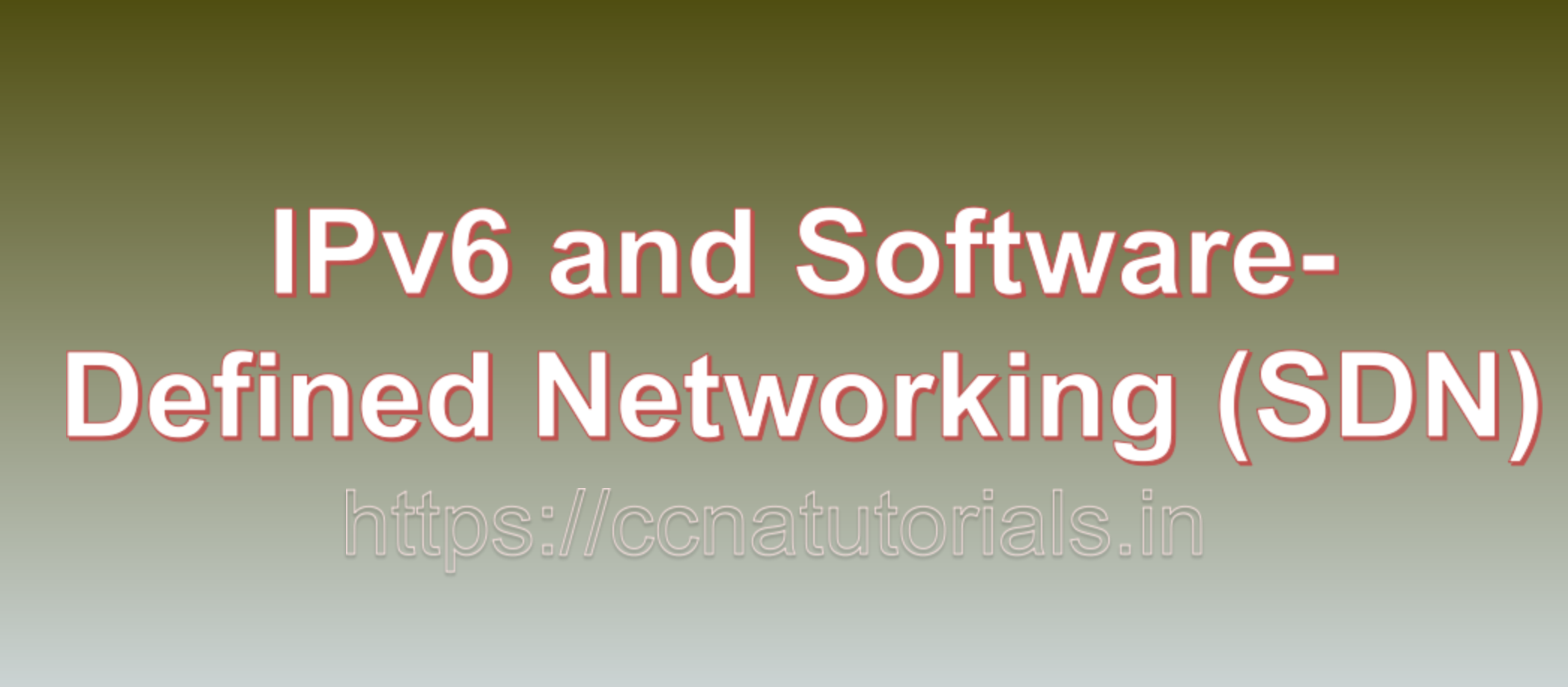Contents of this article
In this article, I describe IPv6 and Software-Defined Networking (SDN):Revolutionizing Network Control and Scalability. The integration of IPv6 (Internet Protocol version 6) with Software-Defined Networking (SDN) has brought about a paradigm shift in the way networks are designed, managed, and controlled. SDN is a network architecture that separates the control plane from the data plane, allowing centralized management and dynamic control of network resources.
IPv6 complements SDN by providing a larger address space, efficient routing, and enhanced connectivity. This integration enhances the capabilities of SDN, enabling scalable and flexible network configurations. In this article, we will delve into the synergy between IPv6 and SDN, their advantages, implementation considerations, and provide examples to illustrate their importance in modern network infrastructure.
Understanding IPv6 and Software-Defined Networking
IPv6: IPv6 is the successor to IPv4, designed to address the limitations of its predecessor by offering a significantly larger address space, enhanced routing efficiency, and advanced features. With the proliferation of devices and the growth of the internet, IPv6 ensures that there are enough unique IP addresses to accommodate this expansion.
Software-Defined Networking (SDN): SDN is an innovative network architecture that separates the control plane, responsible for network management and decision-making, from the data plane, responsible for data forwarding. SDN enables centralized control, programmability, and dynamic resource allocation in networks.
Benefits of IPv6 and SDN Integration
1. Larger Address Space:
IPv6’s expansive address space supports the scalability requirements of SDN deployments, allowing for a greater number of devices and network elements to be addressed.
2. Efficient Routing:
IPv6’s hierarchical addressing and efficient routing mechanisms enhance the dynamic routing capabilities of SDN controllers, optimizing data flow in the network.
3. Global Accessibility:
SDN controllers can manage and configure network resources across geographical locations using IPv6 addresses, supporting distributed network deployments.
4. Flexibility and Programmability:
SDN’s programmable nature is complemented by IPv6’s adaptability, allowing for flexible configuration of network elements based on application requirements.
5. Compatibility with Modern Devices:
As more devices adopt IPv6, SDN can efficiently manage and control a diverse range of devices without the need for address translation.
IPv6 and SDN Implementation Considerations
1. Controller and Infrastructure Compatibility:
SDN controllers and network infrastructure need to support IPv6 to enable seamless integration and management.
2. Network Configuration:
IPv6 addresses must be appropriately assigned to network elements to ensure efficient communication and routing within the SDN environment.
3. Security and Access Control:
Implementing security measures and access control mechanisms is essential to protect the SDN infrastructure, especially when managing resources across different locations.
Examples Illustrating IPv6 and SDN Integration
1. Campus Network Management:
Consider a university campus with a large number of devices and users. By integrating IPv6 with SDN:
– IPv6 addresses are assigned to various devices, including computers, smartphones, and IoT devices, ensuring that each device can be uniquely identified within the network.
– SDN controllers use IPv6 addresses to manage and control network resources, such as switches, routers, and access points, across different areas of the campus.
– Dynamic routing decisions within the SDN environment are optimized using IPv6’s efficient routing mechanisms, ensuring seamless connectivity for users and devices.
2. Data Center Virtualization:
In a data center environment, SDN used to manage and optimize network traffic for virtualized workloads. With IPv6 integration:
– Virtual machines and containers assigned IPv6 addresses, facilitating direct communication between workloads within the data center.
– SDN controllers leverage IPv6 for dynamic load balancing, traffic prioritization, and efficient routing of data between virtualized resources.
– The scalable nature of IPv6 addresses supports the expansion of virtualized workloads, ensuring optimal performance and resource utilization.
3. Multi-Site Network Management:
Imagine a company with multiple offices and data centers in different locations. By integrating IPv6 with SDN:
– IPv6 addresses enable centralized SDN controllers to manage and control network resources across various sites, ensuring consistent configuration and policies.
– Efficient routing using IPv6 addresses optimizes data flow between different locations, enhancing communication and reducing latency.
– Network administrators can efficiently configure and reconfigure network elements using SDN controllers, ensuring seamless connectivity and resource allocation.
Short description of IPv6 and Software-Defined Networking (SDN)
The integration of IPv6 with Software-Defined Networking (SDN) has transformed network architecture and management by leveraging IPv6’s expansive address space, efficient routing, and compatibility with modern devices. SDN’s centralized control and programmability are enhance by IPv6’s adaptability, enabling scalable and flexible network configurations. From campus network management to data center virtualization and multi-site network management, the synergy between IPv6 and SDN empowers organizations to create agile, efficient, and responsive network environments. As the demand for dynamic network configurations and optimized resource allocation grows, the combination of IPv6 and SDN will continue to play a crucial role in shaping the future of network infrastructure.

IPv6 and Software-Defined Networking (SDN): Enhancing Network Control and Efficiency
The integration of IPv6 (Internet Protocol version 6) with Software-Defined Networking (SDN) represents a significant advancement in how networks are designed, managed, and operated. SDN separates the control plane from the data plane, enabling centralized control and programmability of network devices. IPv6, with its larger address space and improved features, complements SDN by providing efficient addressing, seamless connectivity, and support for the growing number of connected devices. In this article, we’ll explore the synergy between IPv6 and SDN, their advantages, implementation considerations, and provide examples to illustrate their importance in modern networking.
Understanding IPv6 and Software-Defined Networking: An Overview
IPv6: IPv6 is the successor to IPv4, designed to overcome the limitations of its predecessor by offering a significantly larger address space, enhanced routing efficiency, and advanced features. IPv6 ensures that there are enough unique IP addresses to accommodate the growing number of connected devices.
Software-Defined Networking (SDN): SDN is an architectural approach to networking that separates the control plane from the data plane. In SDN, network control is centralize through a software-based controller, allowing administrators to programmatically manage and configure network devices.
Benefits of IPv6 and SDN Integration
1. Efficient Addressing:
IPv6’s expansive address space supports the addressing requirements of SDN deployments, including addressing for network devices, virtual machines, and IoT devices.
2. Scalability:
SDN-enabled networks can scale effectively with IPv6, accommodating the increasing number of devices and applications that require connectivity.
3. Simplified Management:
SDN’s centralized control allows administrators to manage and configure the network from a single point, making it easier to deploy and monitor IPv6-enabled devices.
4. Dynamic Routing:
IPv6’s improved routing capabilities enhance SDN’s dynamic routing protocols, optimizing the flow of traffic and improving network performance.
5. IoT Integration:
IPv6’s compatibility with IoT devices enables SDN to efficiently manage and route traffic from a wide range of connected devices.
IPv6 and SDN Implementation Considerations
1. IPv6 Network Infrastructure:
Organizations implementing SDN need to ensure that their network infrastructure supports IPv6 to take full advantage of its capabilities.
2. Controller Compatibility:
SDN controllers must be IPv6-compatible to effectively manage and configure devices with IPv6 addresses.
3. Security Measures:
As with any networking technology, security measures must be in place to protect SDN-enabled networks, especially with the inclusion of IoT devices.
Examples Illustrating IPv6 and SDN Integration
1. Campus Network:
Imagine a university campus network with numerous devices, including computers, smartphones, and IoT sensors. By integrating IPv6 with SDN:
– Each device can have a unique IPv6 address, allowing efficient communication and management of network devices through SDN.
– The SDN controller centrally manages routing, traffic prioritization, and security policies for IPv6-enabled devices.
– IoT devices integrated with IPv6 are seamlessly integrated into the SDN ecosystem, enabling dynamic management and control.
2. Data Center Network:
In a data center environment, SDN and IPv6 integration offer several advantages:
– IPv6 addresses are assigned to virtual machines and containers, providing efficient connectivity in a dynamic and rapidly changing environment.
– SDN’s centralized control optimizes routing, load balancing, and resource allocation for IPv6-enabled applications and services.
– As the data center scales to accommodate more servers and applications, IPv6’s abundant address space ensures that addressing needs are met.
3. Enterprise Network:
For a large enterprise with multiple branches and remote offices, IPv6 and SDN integration enable:
– Centralized control of IPv6 routing and addressing, simplifying management and configuration across diverse locations.
– IoT devices deployed in different branches can communicate efficiently over IPv6, while SDN ensures secure and optimized traffic flows.
– Scalability is supported as the enterprise network expands, with SDN controllers managing IPv6 routing decisions dynamically.
Conclusion IPv6 and Software-Defined Networking (SDN)
The integration of IPv6 with Software-Defined Networking enhances network control, efficiency, and scalability. IPv6’s expansive address space, efficient routing, and compatibility with IoT devices align well with the goals of SDN, enabling centralized management and dynamic optimization of network traffic. From campus networks to data centers and enterprise environments, the synergy between IPv6 and SDN offers organizations the ability to build and manage networks that are prepared for the increasing demands of modern connectivity. As the digital landscape continues to evolve, the integration of IPv6 and SDN will play a pivotal role in shaping the future of networking technologies.






